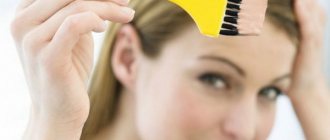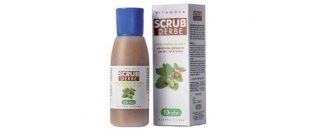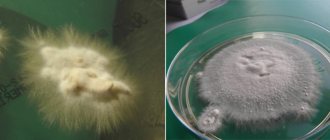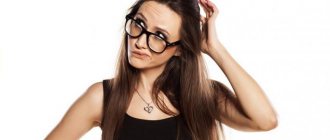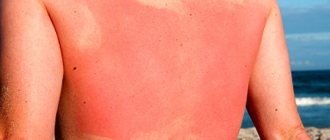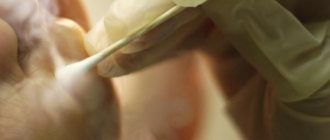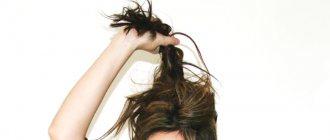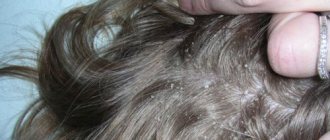Causes
The main cause of burns is the increase in procedure time. The paint cannot be overexposed. Hair should be dyed strictly according to the instructions included with the package. Do not forget that the paint contains alkali, which causes severe burns. Not only redness and swelling may appear, but also blisters followed by suppuration.
Chemical irritation
Often the result of a burn is self-dyeing of hair, or improper use of masks after dyeing. Discoloration of curls can also lead to chemical burns. The consequence of chemical exposure can be partial baldness. There is no need to use a new product without consulting a specialist.
A chemical burn to the head occurs when the composition is not washed off in a timely manner, and the woman does not always understand that she has received damage. Read about the best way to remove dye from hair here.
The symptoms are as follows:
- severe redness on the scalp;
- severe burning sensation;
- itching and peeling;
- blisters;
- suppuration.
If the burn was significant, then you should not treat it yourself, as complications may be irreversible. In this situation, it is better to call an ambulance.
Thermal injury
This type of damage occurs when the scalp comes into contact with hot objects or substances. A burn can occur from washing your hair with hot water, or prolonged exposure to the scorching sun. Sometimes the incorrect use of thermal devices (hair dryer, straightener) also causes damage to the skin.
Allergic reaction
When receiving an allergic reaction to paint, some women wonder why this happened, since they use this paint all the time.
The reason is simple - at a certain moment, an accumulation of the allergen occurs, and as a result, an immediate reaction. It is worth remembering that everyone’s body is different, 15 minutes is enough for one, and several procedures for another. The chemical composition of store-bought paint is quite aggressive - you need to remember this.
Taking antiallergic drugs
When considering the question of what to do for head burns, everyone should know that they will definitely need to take antiallergic medications. Usually prescribed:
- Suprastin . This is a fairly strong antihistamine. Take with extreme caution. It has an affordable price.
- Tavegil . A highly effective remedy that quickly copes with all manifestations of allergies. Also excellently affordable.
Since these pharmaceutical products are very heavy, they must be taken strictly after consultation with a specialist.
Degree of damage
Scalp burns are serious damage to the epidermis, divided into 4 degrees:
- The first degree is superficial damage to the scalp. The consequences are redness, itching, peeling and slight pain.
- The second degree is the appearance of burn blisters that cannot be touched (squeezed or opened). However, sores on the scalp can also arise for other reasons, which we will talk about in more detail here. The pain becomes much stronger, and nausea, headache and dizziness may occur.
- Third degree - deep damage to the epidermis with bruising and purulent ulcers.
- The fourth degree is necrotic damage to the scalp with purulent discharge. With this degree of burn, not only the epidermis is affected, but also the bone tissue of the skull.
Important! The last degree of burn is often incomparable to the life of the patient.
Hair dye burn: symptoms, first aid, precautions
When dyeing your hair, you can get a burn - damage to the skin from the chemical components of the coloring composition.
There is a risk even when using expensive and high-quality dyes, but if the procedure is carried out incorrectly.
The damage can be quite severe, and if proper care is not provided, the victim may lose their hair. So how can you get burned by hair dye and what should you do?
Burn degrees
Head burns are serious lesions of the dermis, which are divided into 4 degrees of severity:
- Mild - these are minor superficial lesions of the scalp. Manifests itself in the form of peeling, itching and mild pain.
- The second degree is the appearance of blisters. The pain is more pronounced, nausea and dizziness are also present.
- Third degree - serious damage to the skin, accompanied by the formation of small wounds and ulcers.
- Fourth degree - death of skin cells occurs, accompanied by the release of pus. At this stage, bone tissue is also affected.
What to do urgently?
A burn to the scalp is a terrible and unpleasant occurrence, but there is no need to panic - you need to act decisively and quickly.
- First of all, you need to quickly wash off the paint, or remove boiling water when exposed to heat.
- A cooling bandage or a swab soaked in cold liquid should be applied to the injury.
- To prevent infection, the damaged area is treated with antiseptic compounds.
- If the damage occurred as a result of acid-containing compounds, they are neutralized with alkali (soap or soda composition).
- Damage by alkali, on the contrary, is neutralized with a weak solution of acetic or citric acid.
- Next, you should rinse your hair with cold, running water. It is strictly forbidden to use water if the burn occurred as a result of exposure to sulfuric acid or an organic aluminum compound. If you have a sunburn, give the patient plenty of fluids to drink.
Expert opinion
Zemlyanukhina Tatyana Vyacheslavovna
Ambulance and emergency paramedic at the Clinical Emergency Hospital #7 in Volgograd.
Ask an expert
For any burns, including chemical ones, be careful when using antiseptics. Under no circumstances should you wash an open wound with a concentrated alcohol solution, and certainly not experiment with acids and alkalis. There is a high probability that a reaction will occur that is not at all what was expected. In such cases, it is best to use antiseptics that do not contain active organic compounds, for example an aqueous solution of chlorhexidine.
Allergy Prevention
On the face, the skin often seems capricious and problematic, but in fact under the hair it is even more delicate and requires careful care. It quickly becomes clogged, hair roots often settle and do not sit as they should, various kinds of rashes and pimples appear, and not all shampoos help maintain healthy hair. The toxic mixture in this case is another factor that worsens the condition of the head, which is why it is necessary to conduct a hair dye allergy test. Most manufacturers recommend applying a small amount of the contents of the tube to particularly delicate areas of the skin 48 hours before use: the bend of the elbow, the skin behind the ear, and the neck.
It is recommended to keep the paint on for about half an hour and then wait for the consequences. If they are not there, accept congratulations and feel free to experiment with the image. Slight redness, itching, and swelling indicate that the money spent on packaging the poison was wasted. Don’t be upset, there is always henna and basma in stock, they are certainly natural.
How and how to treat burned skin?
Negative consequences from a burn can be avoided if first aid is provided to the victim in a timely manner.
For minor injuries, treatment can be carried out at home, but if the burns are deep, the victim must be hospitalized or shown to a doctor.
- Superficial injuries are treated conservatively - bandages with anti-inflammatory and antibacterial compounds are applied. As soon as healing begins, the bandages are removed and the burn area is treated with moisturizing, healing preparations, and, if necessary, an anesthetic ointment is applied.
- If the burns are deep, then surgical intervention is indispensable, since it is necessary to remove necrotic formations and at the same time restore the integrity of the skin. Skin grafting is used if bone tissue is damaged.
Medications
The scalp after a burn is very sore and itchy, and inflammation and swelling may appear.
The first assistant in this situation is “Panthenol” ointment. The cost of these drugs at the pharmacy is around 350 rubles. Apply the composition to a clean and dry damaged area of the scalp, in a thick layer 3 times a day. The ointment helps after the first use, inflammation and itching go away, and with prolonged use the burn heals quickly.
In pharmacies you can find an analogue of this drug “D-Panthenol” - the price is 150 rubles. The action is absolutely identical. For a burn of any degree, you need to use antiallergic drugs, this can be:
- Tavegil - drink according to instructions, the cost of the drug is 120 rubles.
- Suprastin is a fairly strong medicine, so they drink it with caution; the price of the medicine in pharmacies is 100 rubles.
Important! Pharmacy medications are taken after consultation with a doctor.
Folk remedies
There are inexpensive folk recipes that will help get rid of the effects of scalp burns at home. These can be herbal infusions, decoctions.
Chamomile and St. John's wort
Preparing a decoction is not difficult:
Compound:
- Chamomile flowers – 2 tbsp. l.
- St. John's wort herb – 1 tbsp. l.
Preparation:
- Mix these components and pour half a liter of boiling water and leave for an hour.
- The composition is applied to the hair along the entire length and is not washed off.
Honey
Another great way to restore your scalp after a burn is to apply fresh bee honey. This product is unique; when you use it, itching and redness will go away, and the pain will become much less. Honey in its pure form is applied to damaged areas several times a day, and burn blisters will not appear.
If the damage to the scalp is significant, home treatment does not help, or complications occur, consult a doctor immediately. Don't wait until the consequences become irreversible.
Scalp burn after dyeing: symptoms and treatment methods
Burns
A hair dye burn is chemical damage to the skin due to improper dyeing procedures or poor-quality composition of the product. Proper first aid is necessary to minimize the burn area.
Composition and effect of paint
Hair dye is a product that provides a sharp transition from one color to another. The change in shade occurs due to complex chemical reactions of coloring pigments and hair structure.
The composition necessarily includes an oxidizing agent, most often hydrogen peroxide plays its role. The largest amount of brightening agent is contained in permanent permanent dyes.
The dye may be present with the oxidative pigment to form a cosmetic pigment. Hair color depends on the amount of time spent.
Ammonia paints have a strong effect. The substance causes skin irritation and aggravates existing allergic reactions.
Coloring is impossible without two components: paint and oxidizing agent. The mixture is diluted exactly as indicated in the instructions for use. Any deviation from the specified dosages leads to an increase in the concentration of the solution and threatens to cause burn damage to the skin.
Signs of head burns
A scalp burn after dyeing is manifested by a number of the following signs:
- itching, burning, redness;
- increased body temperature;
- the appearance of blisters;
- the face has severe swelling;
- hair loss;
- deterioration in general health;
- fever;
- gagging, nausea;
- shortness of breath, hypotension;
- cardiopalmus.
Before starting treatment, the extent of the burn should be determined.
| Burn degree | Sign |
| First degree | Painful red areas that peel off appear. The pain intensity is moderate. |
| Second degree | Symptoms of the first degree include watery blisters. There is severe pain with migraine and nausea, the damaged area is hot. |
| Third degree | Signs may include severely damaged scalp with ulcers and purulent bleeding. Gradual necrosis of soft tissue occurs. |
Intense deep injuries are incompatible with life. It is necessary to have a doctor examine the burned areas.
Methods for treating burns
The first stage of assistance includes getting rid of the mixture on the victim’s hair. First, you need to apply a cloth soaked in cold water to the affected area. An alternative to this method is to wash your hair under an ice-cold stream of water. This will help relieve pain and swelling at first.
Afterwards treatment with antiseptic drugs (Chlorhexidine, Miramistin) is needed. It is important to consider the possibility of allergic intolerance to the components of the antiseptic. The medicinal solution should be diluted exactly as in the instructions.
With the help of the medicine, the damaged areas are irrigated or a compress is applied.
When you get a burn, your head starts to hurt, your skin becomes inflamed and itchy. The best assistant in this situation is Panthenol ointment. Apply a thick layer to dry and clean damaged skin 2-3 times a day.
After a couple of procedures, the pain will go away, inflammation, itching and peeling will disappear. When using, it is important to consider that Panthenol can get burned due to its concentrated composition.
An analogue of this drug with a gentle effect is D-Panthenol.
A simple home method to relieve unpleasant symptoms is to rinse your hair with herbal infusions (St. John's wort, chamomile). To cook take 2 tbsp. l chamomile and 1 tbsp. l St. John's wort is placed in a container and boiling water is poured. Infuse the decoction for about an hour. Apply over the entire length of the hair, no need to rinse.
A popular way to treat damaged skin is bee honey. Thanks to the unique substances contained in honey, redness disappears and pain is eliminated. The main advantage of the method is that blisters do not pop up. The honey mixture should be applied to the affected areas twice a day.
After receiving a burn, it is imperative to ingest antiallergic drugs, such as Tavegil and Suprastin. Take one tablet 2 times a day. The daily dosage should not exceed 6 tablets.
Vitamin and mineral complexes are prescribed to help restore the body's immune defense.
The burn area should be kept clean and treated with special ointments and creams (Methyluracil, Bepanten, Solcoseryl).
Possible consequences and precautions
It is common to get burned when performing health procedures for hair follicles. One of these is a mask based on mustard powder.
Under the influence of caustic mustard, damage to the skin occurs, accompanied by hyperemia, itching, burning and pain. The main condition for eliminating puffiness is cool water with shampoo.
It is necessary to wash your hair several times in a row to remove any remaining irritating component. After applying a kefir mask, rinse your head with a chamomile solution.
There are several recommendations on how to safely color your hair:
- It is prohibited to mix paint components in metal containers. The dye and metal enter into a chemical process, which results in the appearance of harmful components.
- You need to immediately color the roots with the prepared mixture and then distribute it evenly over the entire length of the hair. Long-term storage of paints affects the quality of the product.
- Painting will be as safe as possible if you choose a quality product with a dermatological control mark.
- Gentle coloring includes the use of products without ammonia and hydrogen peroxide.
- An important rule is to pay attention to the expiration date of the product.
- Blondes and brown-haired women can use natural henna as an alternative, which can color their curls harmlessly.
- After dyeing, special care is required using medicinal masks, herbal decoctions, and professional products.
If symptoms do not disappear, you should urgently contact a trichologist for additional treatment.
The right choice of products will prevent unpleasant consequences after dyeing your hair. It’s better to overpay and buy a trusted brand than to buy inexpensive paint and end up with skin injury.
The article has been verified by the editors Link to the main publication
articles:
(1 5,00 of 5) Loading...
Didn't find suitable advice?
or see all questions...
Source: https://BezTravmy.ru/ozhogi/ot-kraski-dlya-volos.html
Prevention measures
Experts give the following recommendations for safe hair coloring:
- do not mix paint components in metal containers;
- the paint is prepared before the procedure; storage of the composition is unacceptable;
- choose only proven formulations that have been tested by dermatologists;
- try to use paint with a minimum content of harmful chemical components;
- When purchasing, look at the expiration dates;
- If possible, use natural dyes, such as henna.
Advice! After each use of coloring compositions, use medicinal masks, rinses, and herbal decoctions.
Manifestation of the first signs
It's no secret that hair dye is toxic and dangerous both for the strands themselves and for the scalp. Every attempt to change the color can lead to irreversible consequences, serious illnesses, long trips to the doctor, and it all starts with a seemingly harmless process: a mild allergy to hair dye. Symptoms that go unnoticed in time later result in dermatological diseases, so it is important to be careful before the procedure itself.
Many people take the itching that appears rather lightly when applying the mixture. Others prefer to “drive in” the coloring matter with a brush to achieve a better result. Still others are not at all disdainful of leaving careless smears of hardening slurry on areas of the skin. But this is very dangerous.
An allergic reaction may not manifest itself immediately, but only the next day. Redness and itching indicate that the dye contains large quantities of dyes. Facial swelling and blisters indicate the harmful effects of certain components of the paint, such as oxidizing agents and strengthening agents.
A truly terrible consequence of hair dyeing is anaphylactic shock, leading to damage to the mucous membranes and problems with the respiratory tract.
The so-called urticaria spreads throughout the body and leads to nausea, swelling of the face, and headaches.
The most difficult thing to treat is dermatitis, which, if you’re lucky, goes away after two months of taking medication, but treatment can take years.
